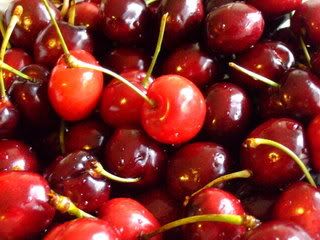One of the most common questions asked of a raw foodist is "where do you get your protein?" Although the only person who's ever asked me that is my mother, I figured I'd post some protein information for other newbies to the raw food lifestyle so you can tell your own mothers (and other relatives, friends and acquaintances) that yes, you can get complete proteins without eating meats or dairy. I got this from a nutrition guide at the university bookstore. This is one of those guides they provide to people majoring in nutrition or food science. I would encourage people to pick up this kind of information as well, just as a reference guide.
Complete proteins are considered high quality for humans because they contain all of the essential amino acids. They are easily digestible. Foods in this list include
Now, for those of us who eschew meat and dairy, where should we look? Plant proteins are considered complementary proteins because not only can we not get all of our essential amino acids from one plant, we'd have to eat a lot more plants per serving than meat or dairy to get the same amount of protein. However, by combining complementary proteins, you can create a meal containing all of the essential amino acids- a complete protein meal.
Here are foods belonging to the complementary protein category:
You basically combine foods from this list that "compliment" one another to form complete proteins. You therefore don't have to have a complementary protein along with meat or dairy. My nutrition guide says you can combine:
The guide says that the protein requirements (Recommended Daily Allowance) in grams is only .8 g of protein per kg body weight per day for people aged 19 and up. (I hate it when measurements are done using the metric system!) I invite someone to do the math if you are willing. There are also charts on the internet that you can use to calculate daily grams of protein per day.
I never really thought about how I can combine plant proteins. All I remembered was that old adage about beans and rice making a complete protein. I never would have considered vegetables plus nuts, for example, as fulfilling a complete protein requirement. I'll be sending this post to my mother posthaste!
I hope this information was helpful to others.
-Allison
UPDATE, Jan. 29, 2006
I received an excellent comment from someone who states that the above information is outdated and inaccurate because 1) it's been discovered that plants have all of the essential amino acids humans need and require no combining and 2) raw plant protein is better utilized by the body and therefore less protein is needed than is traditionally recommended. (If you click on the "comments" link below this post you can read the entire entry).
Unfortunately, protein is one of the controversies faced by the raw food/vegan/vegetarian community. What I printed above is certainly not considered outdated by all people -indeed, this information can be found on recent entries at medical sites like WebMD, and is still widely published and taught. So here is another area where raw foodists just have to decide for themselves what they want to do: go with traditional advice or believe that this advice has been proven false. You'll find ardent supporters on both sides of the table. Personally, I'll be doing a lot more reading and investigating before I consider the old information outdated, but I am always open to learning.
Thanks again for the input.




1 comments:
This protein information is based on cooked food, not raw, and it's not really accurate and up-to-date anyway. You don't need to combine "complementary" sources of amino acids in order for your body to get protein.
For a very simple explanation, I strongly suggest you get "Green for Life" the new book by Victoria Boutenko.
Also, Alissa Cohen's book discusses it as does Brigitte Mars' book "Rawsome" and most all other raw books.
Just keep in mind that the information you get from most traditional nutritional sources is just not valid. I know this is a difficult hurdle to overcome, but, once you do, you'll be free from that dogma that's based on cooked poisons that have made people sick enough to have to have doctors and "experts" tell them what to eat!!
The simplest response to "where do you get your protein" is "the same place the cows do." That usually shuts people up!! AND ... more importantly, gets them to thinking.
Post a Comment